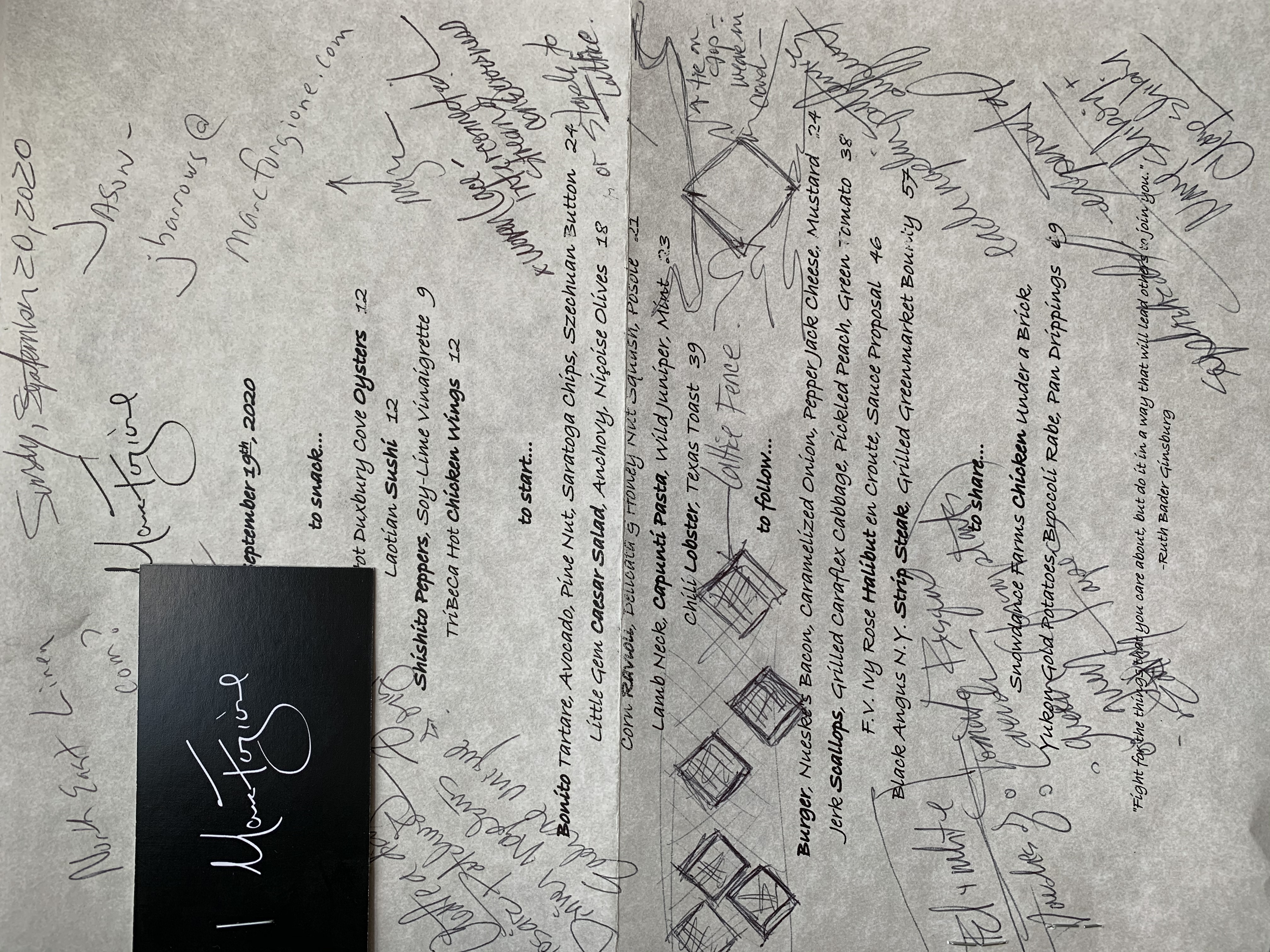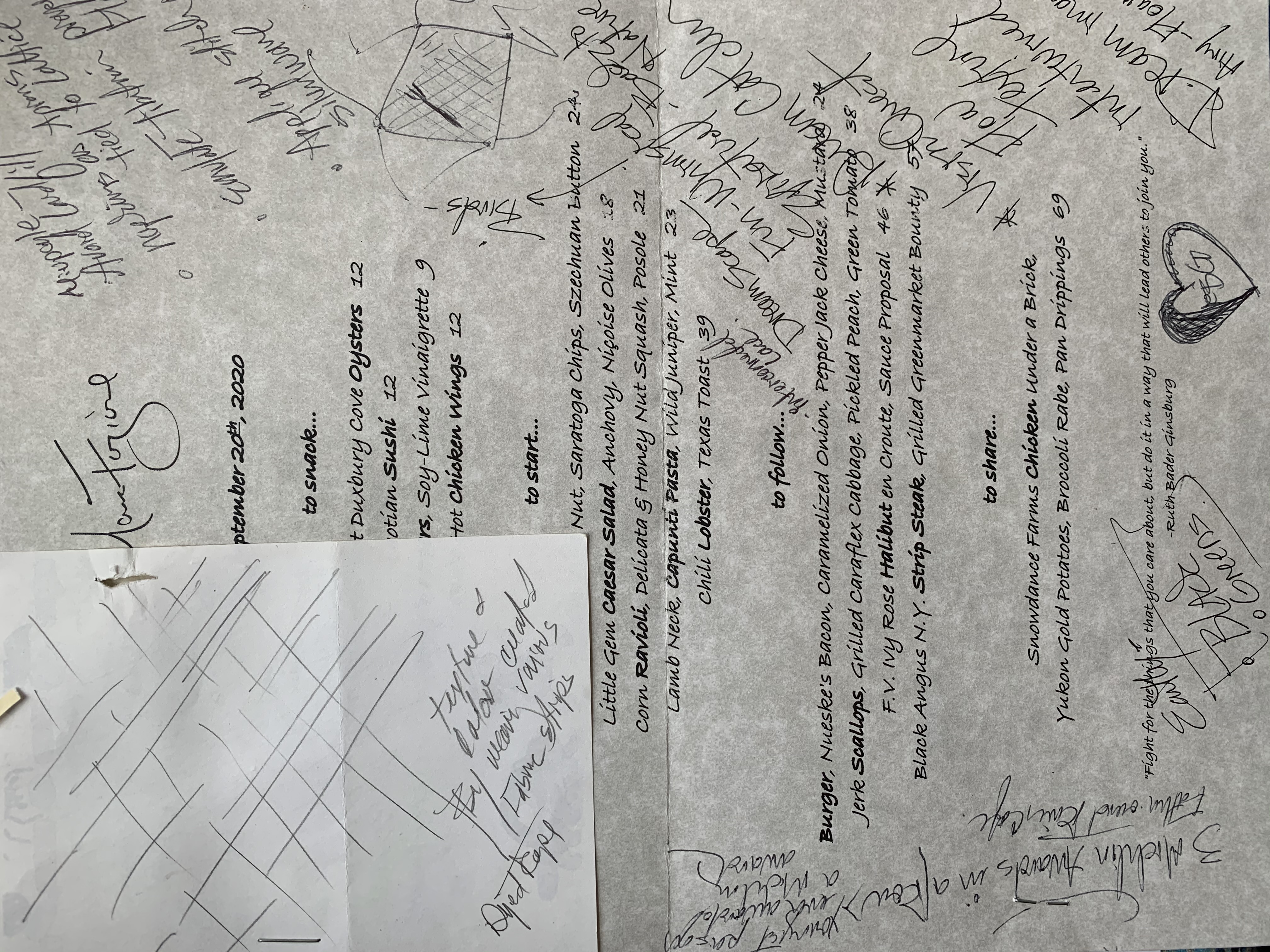Neighborhood Curbside Canvas Project: DREAMSCAPE UNEVEN PLAID @Restaurant_Marc_Forgione
Posted by Mary Jaeger on 2nd Oct 2020
Mary Jaeger, textile and fashion designer, collaborated with Restaurant Marc Forgione, 134 Reade Street, for the Neighborhood Curbside Canvas Project.
The open structure of the wooden lattice framework defining the curbside café of Marc Forgione was perfectly suited for a super-sized woven textile design. Intertwining strips of solid black and tonal green stripe fabrics in an uneven plaid pattern compliments the organic layering of flavors created in the kitchen. The simple materials will mesh with the season as it progresses and weather accordingly.
I was immediately excited about the Neighborhood Curbside Canvas Project (https://www.curbsidecanvas.com/streeatery-art/marc-forgione/mary-jaeger) when Bill Tsapalas approached me to participate as an artist, pairing me with Marc Forgione. THE NEIGHBORHOOD CURBSIDE CANVAS PROJECT is a volunteer grassroots effort, uniting local artists with struggling New York City restaurants to transform pop-up dining patios into street art, for the purposes of driving greater interest, energy and business back into our COVID-coping neighborhoods. The project from introduction to conception to completion took about 2 weeks.
My collaboration with Marc Forgione was an organic process that started with my initial thrill about the open structure of the wooden lattice framework defining the curbside café (56’ long x 4’ high). The natural color of the wood framed by the matte black frame of the restaurants façade created a sophisticated, neutral background. The black metal planters separating dining tables were filled with fresh lavender and sage-type grasses, adding a natural element to the street café. This project would be my largest outdoor installation.
My artistic vision suggested several concepts to explore and I did a series of loose pencil sketches to explore possible solutions:
- Paint with a gradation of diagonally placed colors, shapes and lines
- Large textile panels designed with shaped resist dye patterns (shibori) attached to lattice work
- Mosaic patchwork of reimagined fabric dinner napkins dyed with shaped resist patterns - cords would be stitched to the napkin corners and woven into the lattice structure like apron ties (the upcycling process would save the napkins from a landfill site)
- Super-sized uneven woven textile plaid design referencing my explorations with shaped resist textile dyeing work
I spoke with Jason, weekend manager, the afternoon of Sunday, September 20, who explained the story behind the restaurants origins – Chef Marc Forgione grew up in the restaurant business, joining his father, Larry Forgione in the kitchen of American Place, known for the sparking farm-to-table movement. The world acclaimed chef Larry Forgione at one point was the head chef and the owner of The River Café in Brooklyn. Marc won season three of The Next Iron Chef in 2010 and is the youngest chef to be awarded the Michelin star in 2012.
Dominique, the general manager of Marc Forgione, and I met on Monday, September 21 in the afternoon to discuss the scope of the project and specific design concepts. When I spoke about the woven uneven plaid she immediately lit up and said “that sounds perfect – it integrates with the melding of natural favors we create with our menu, the experimental dreamscape nature of the chef’s vision and our relationship with the neighborhood. The chef loves dream catchers! We shop at the Tribeca Farmers Market for our fish, produce and meats.” She explained only natural materials were used in the interior design of the restaurant – wood shelves and tables, sand-colored ceramic dishes, grey-colored napkins, black-colored interior walls and façade – and these concepts were carried through to the outdoor café with the natural wood-tone of the lattice.
We decided the main color of the plaid should be black, because the exterior of the restaurant is black and as it naturally weathers it will not discolor or look dirty from street traffic. Dominique mentioned there may be some staining during a rainstorm from the shellac finish on the lattice. As an accent color we thought a range of green tones would suggest nature, the change of seasons from summer to fall, and compliment the lavender growing in the planters and the variety of decorative pumpkins and gourds that will be placed on top of the fence creating a festive autumn dining atmosphere.
Artists for this project are responsible for providing materials, knowing they may get reimbursed in full or partially by a Go Fund Me account (https://www.gofundme.com/f/neighborhood-curbside-c. I contacted several colleagues in the fashion industry to see if they had black and green fabric they might consider donating. No one did. Due to my schedule’s constraints, I purchased solid black cotton/polyester fabric (12 yards, 50” wide) and a green and gold woven damask stripe (3 yards, 55” wide) at Rita’s on the Lower East Side which was on my bike path between my Brooklyn atelier and Tribeca apartment on Friday (9/25) afternoon, just before they closed for the Jewish Holiday Rosh Hashanah.
The first step of the installation began at home on our terrace. I hand-ripped the black fabric into 7” x 6 yard long strips, leaving the soft edges deconstructed. On Monday (9/28) at noon, I set-up a temporary on-site studio outside the restaurant on a square dining table and hand-cut the green stripe damask, enjoying the company of honey bees as they searched for nectar from fresh lavender growing next to me.
My assistants for the collaborative weaving project were Vicki Khuzami, fine artist and muralist, @vicki_khuzami_art, and Edith Liben, artist and gap year student, @edeathz. We started this organic weaving process by methodically lacing the black strips through the lattice in a diagonal bias fashion, creating a background texture and structure integrating the entire length and width of the lattice wall. The 2” x 6’ green stipe pieces were integrated by weaving them in and around the base pattern, conscious of the movement of the lines and open spaces. Overhand knots were tied to anchor all the strip ends to the lattice. The five vertical structural poles were partially wrapped in a crisscross fashion with the green stripe damask and tied with overhand knots placed toward the dining area side as points of visual interest.
The final knots were tied between sprinkles of raindrops on Tuesday (9/29) afternoon. As I stepped across the street and looked at the DREAMSCAPE UNEVEN PLAID, my eyes was flowed smoothly and easily enjoying the integration of the outside café structure with the front of the restaurant. The movement of the street scene with cars, delivery trucks, pedestrians walking dogs and pushing strollers, and bikers, etc., all added to the motion of the textile pattern --- and cohesiveness of the outdoor cafes newly created on Reade Street.
My HOPE is that the UNEVEN PLAID will excite a dialogue between the restaurant and its dining patrons. It will be interesting to watch how the installation changes as the weather moves from early fall to late fall and winds and precipitation react with the natural cotton and indestructible polyester.
Mary Jaeger @maryjaeger_ny
Assistants:
Vicki Khuzami @vicki_khuzami_art
Edith Liben @edeathz
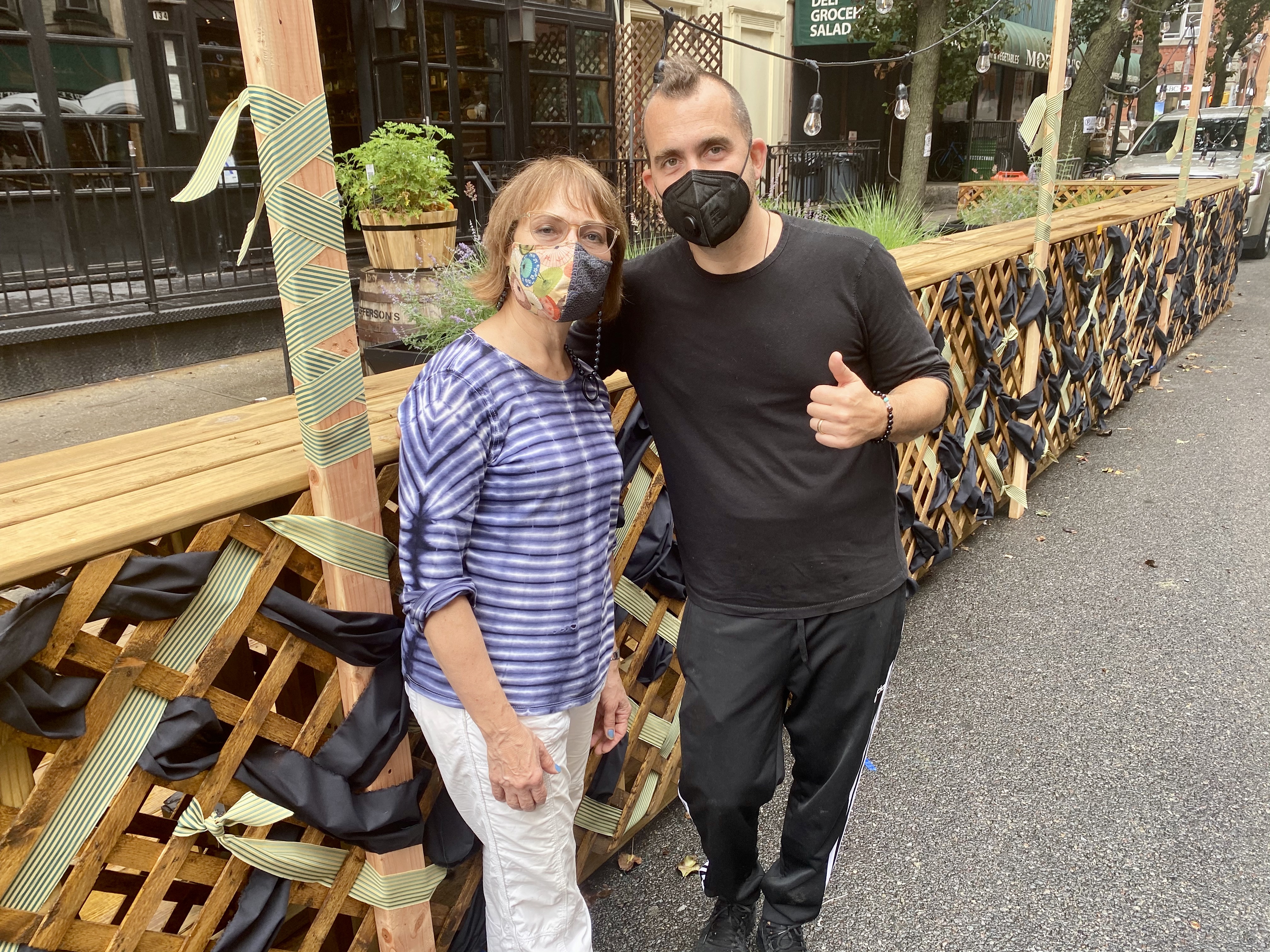
Mary Jaeger and Marc Forgione in front of the completed outdoor cafe: DREAMSCAPE UNEVEN PLAID
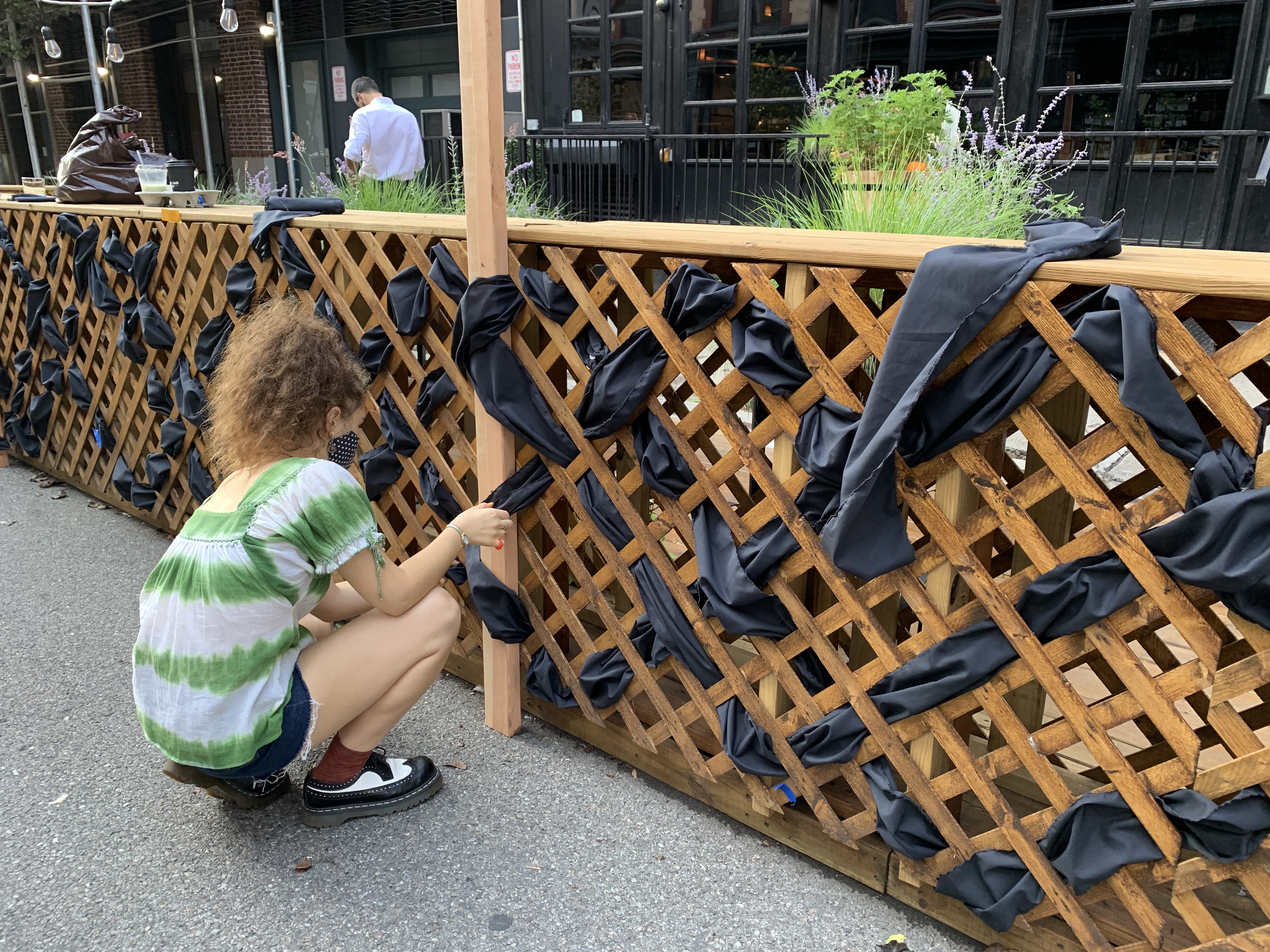
Edith Liben methodically weaving the wide black strips of fabric on the south side (38') along Reade Street
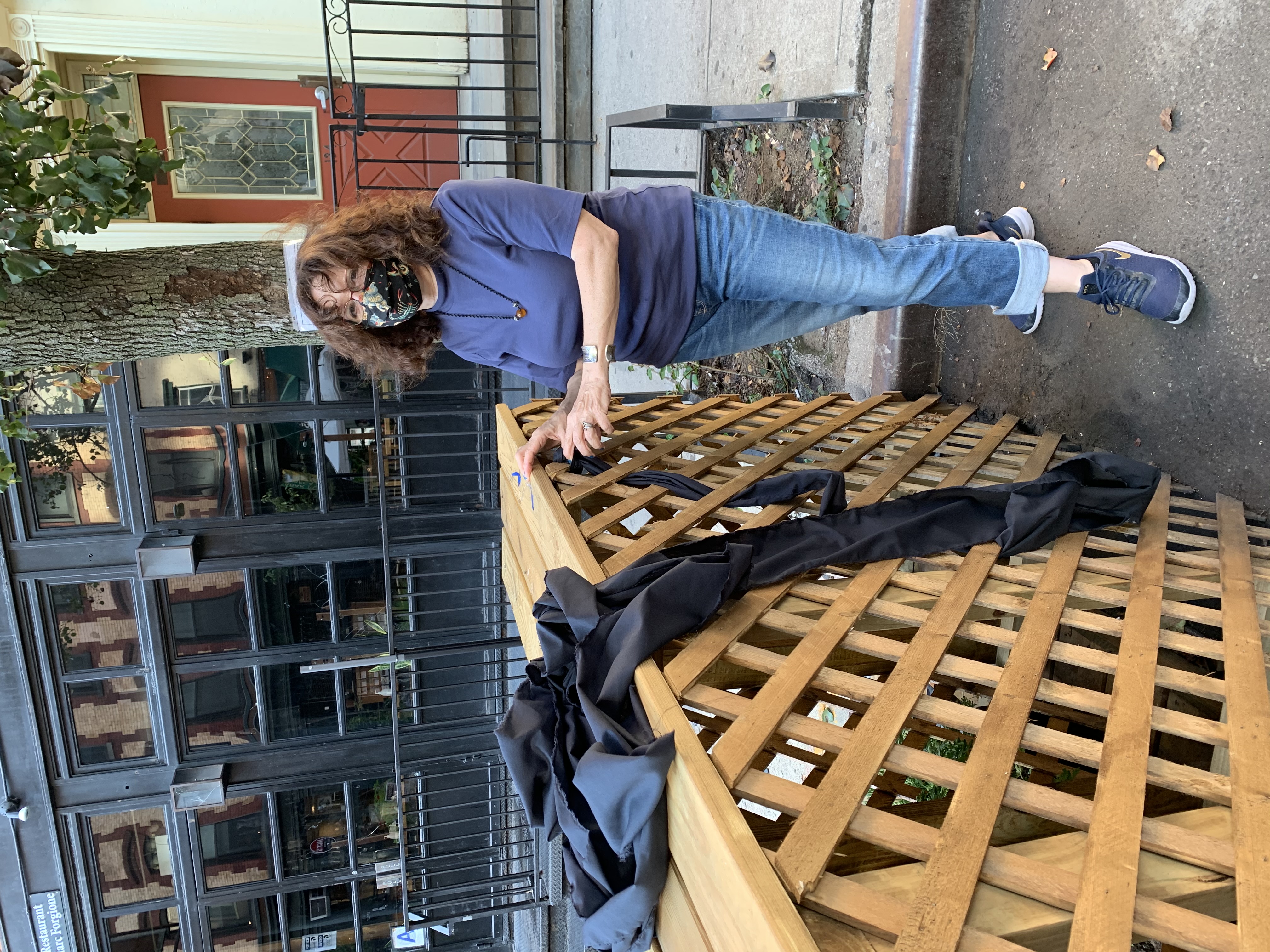
Vicki Khuzami beginning the weaving process of the black strips on the east side (8' long)
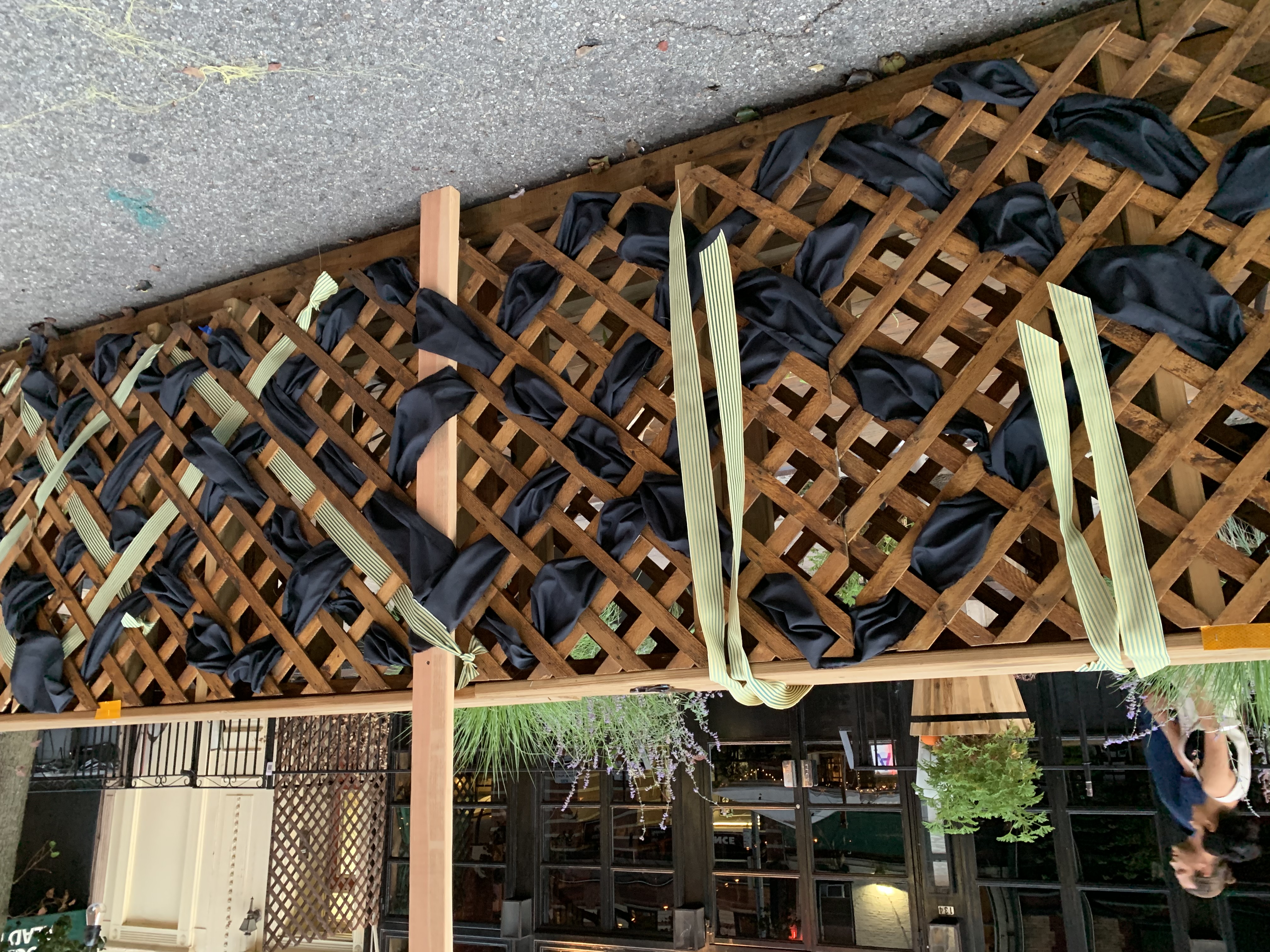
Weaving in the narrow green strips of damask stripe fabric as an accent over and around the black diagonal base
CONCEPTS FOR THE CURBSIDE CANVAS DESIGN:
- Large textile panels designed with shaped resist dye patterns (shibori) that could be attached to the lattice facade
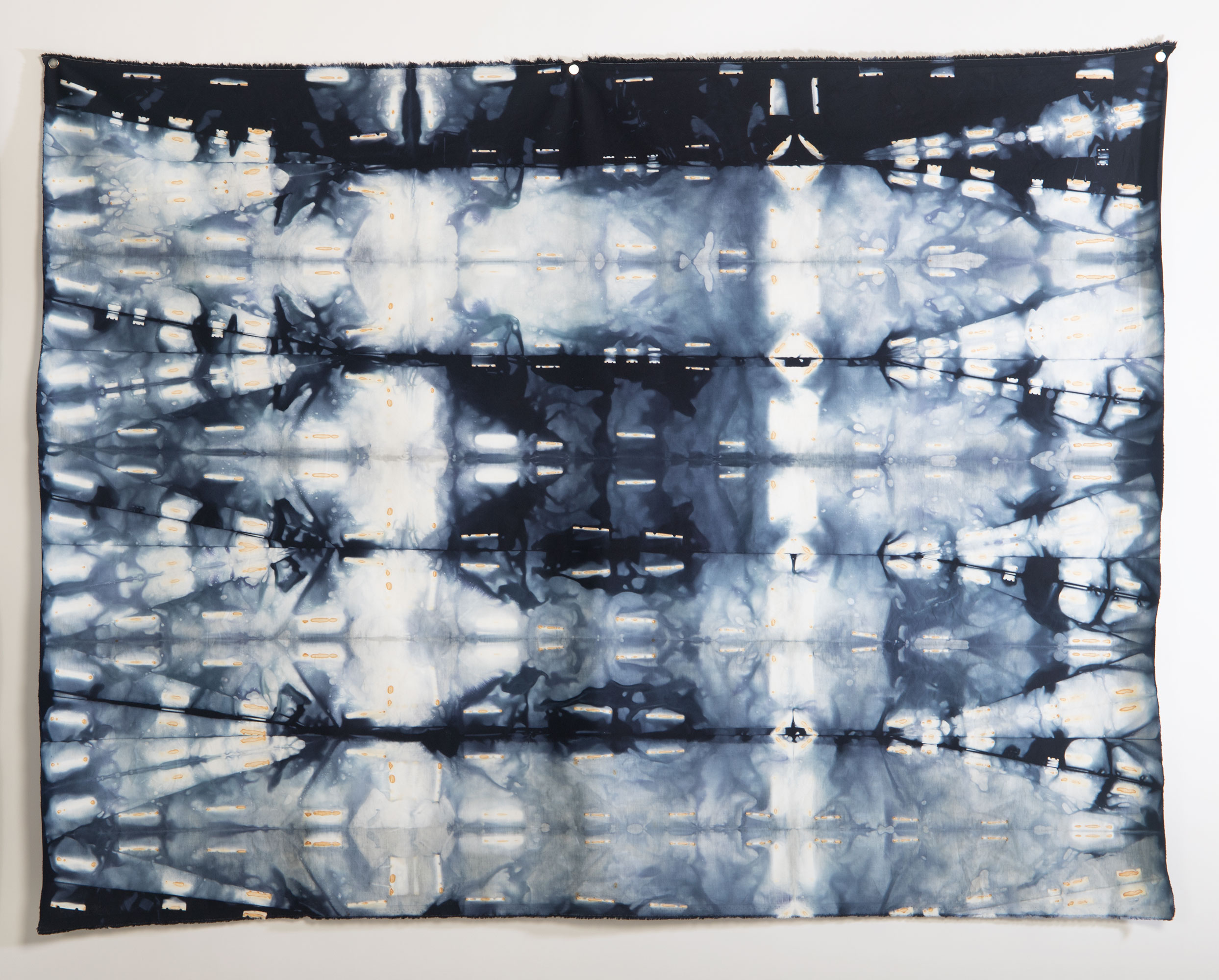
Black/Indigo Illusion (cotton with spandex) 60" w x 50" h
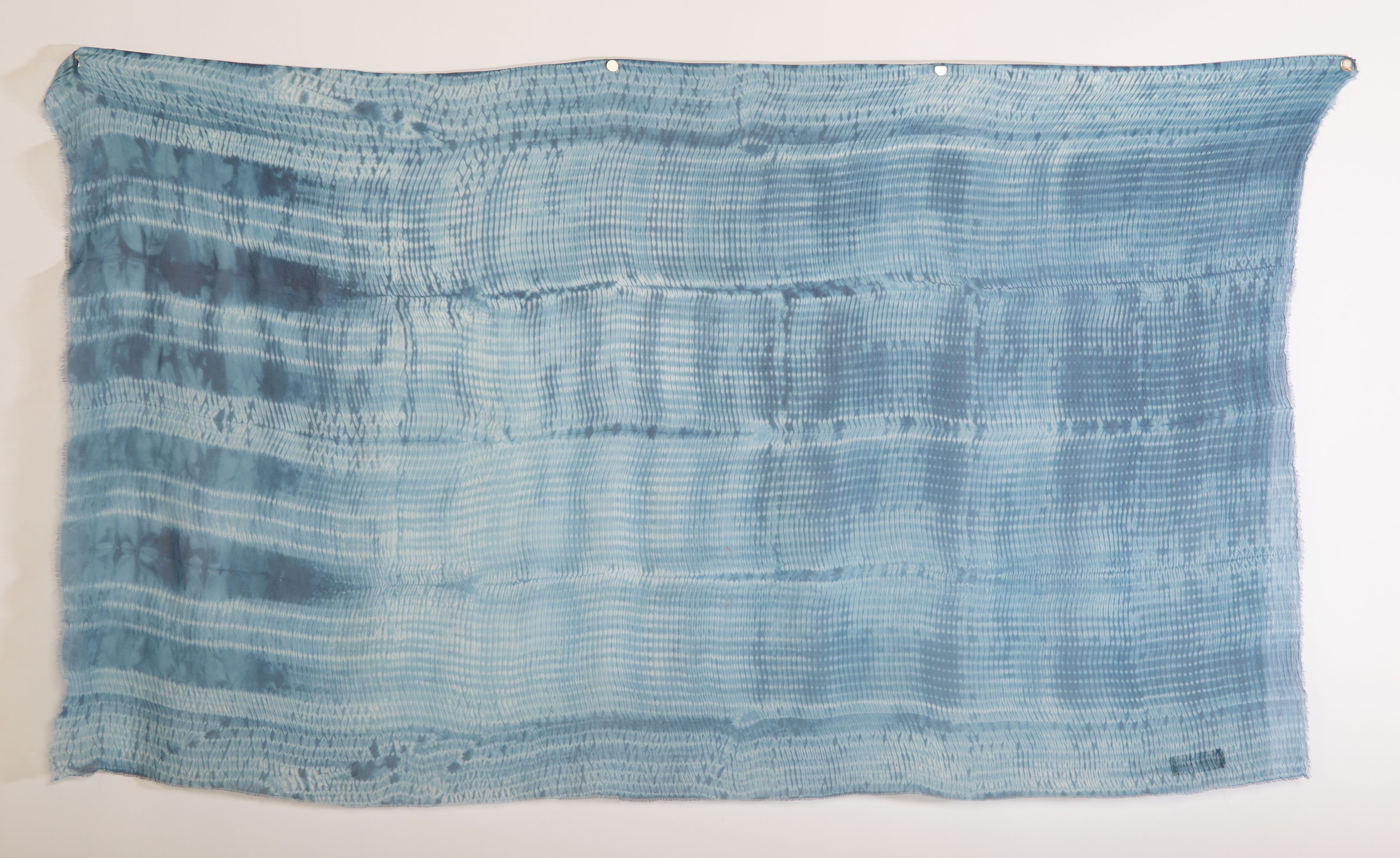
Blue Unveven Plaid (silk chiffon) 50" w x 30" h
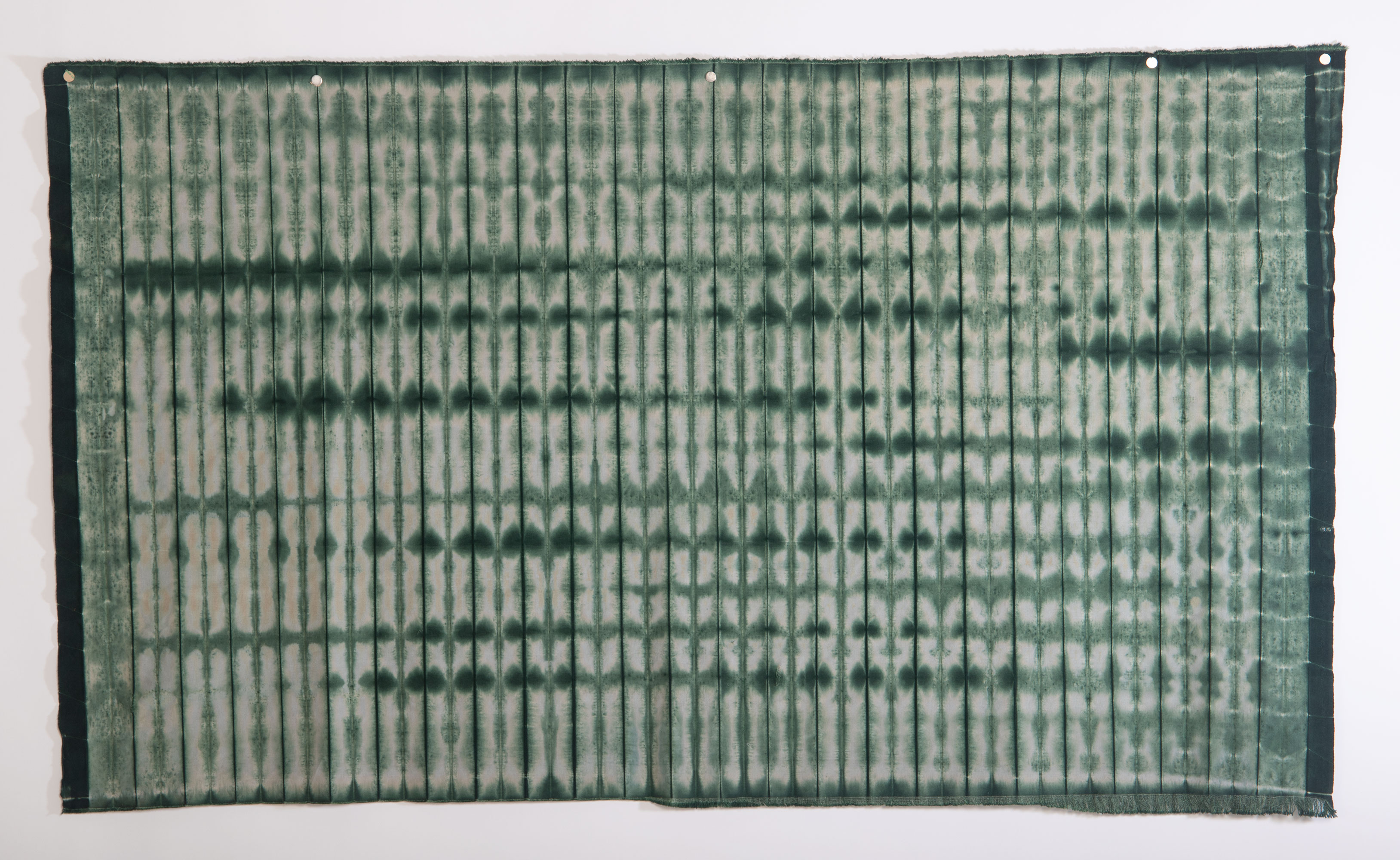
Green Pleats (brushed cotton canvas) 55" w x 32" h
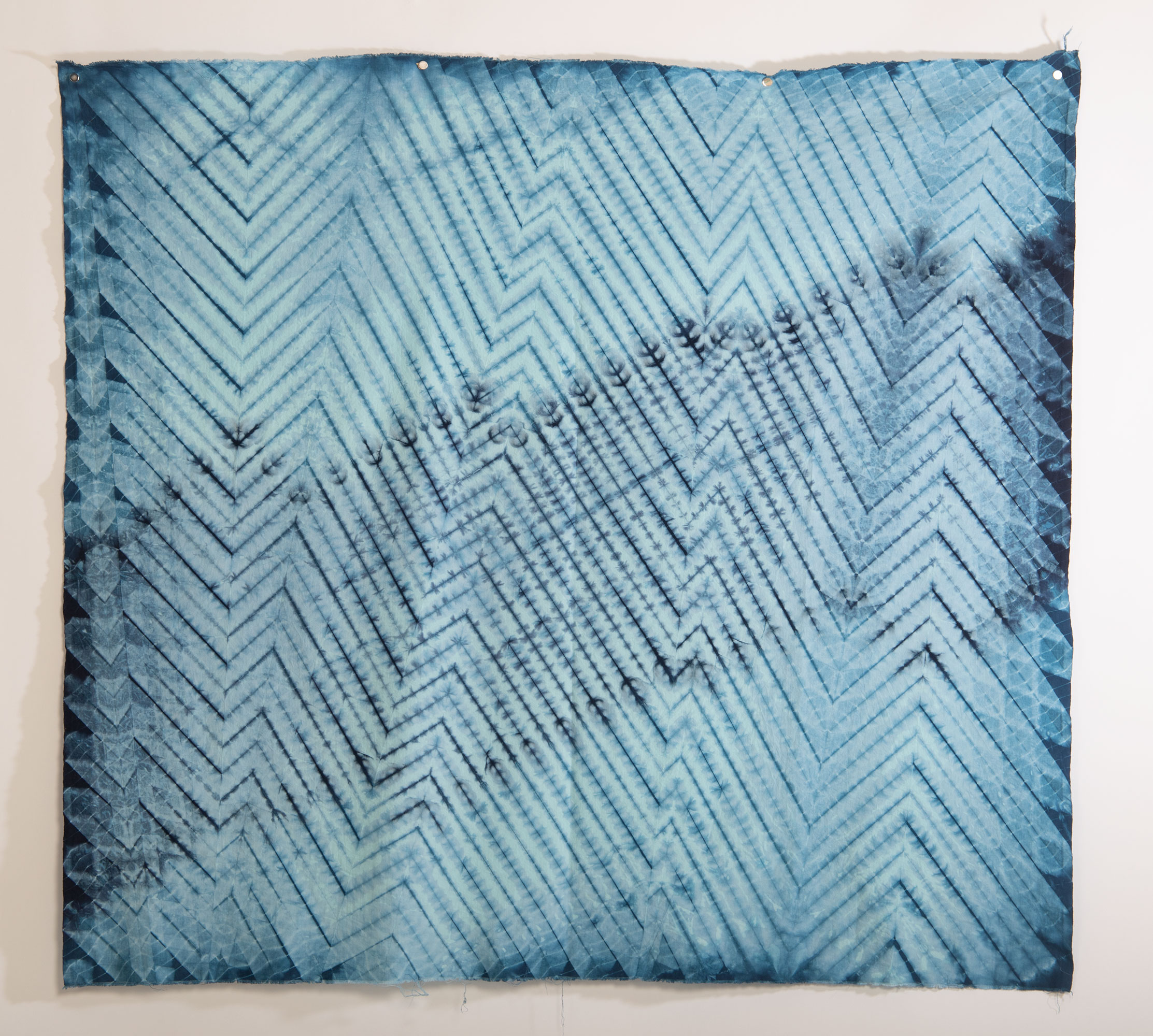
Blue ZigZag (cotton broadcloth) 55" x 60" h
- Mosaic patchwork of re-imagined fabric dinner napkins dyed with shaped resist patterns - cords would be stitched to the napkin corners and woven into the lattice structure like apron ties (the up-cycling process would save the napkins from a landfill site)
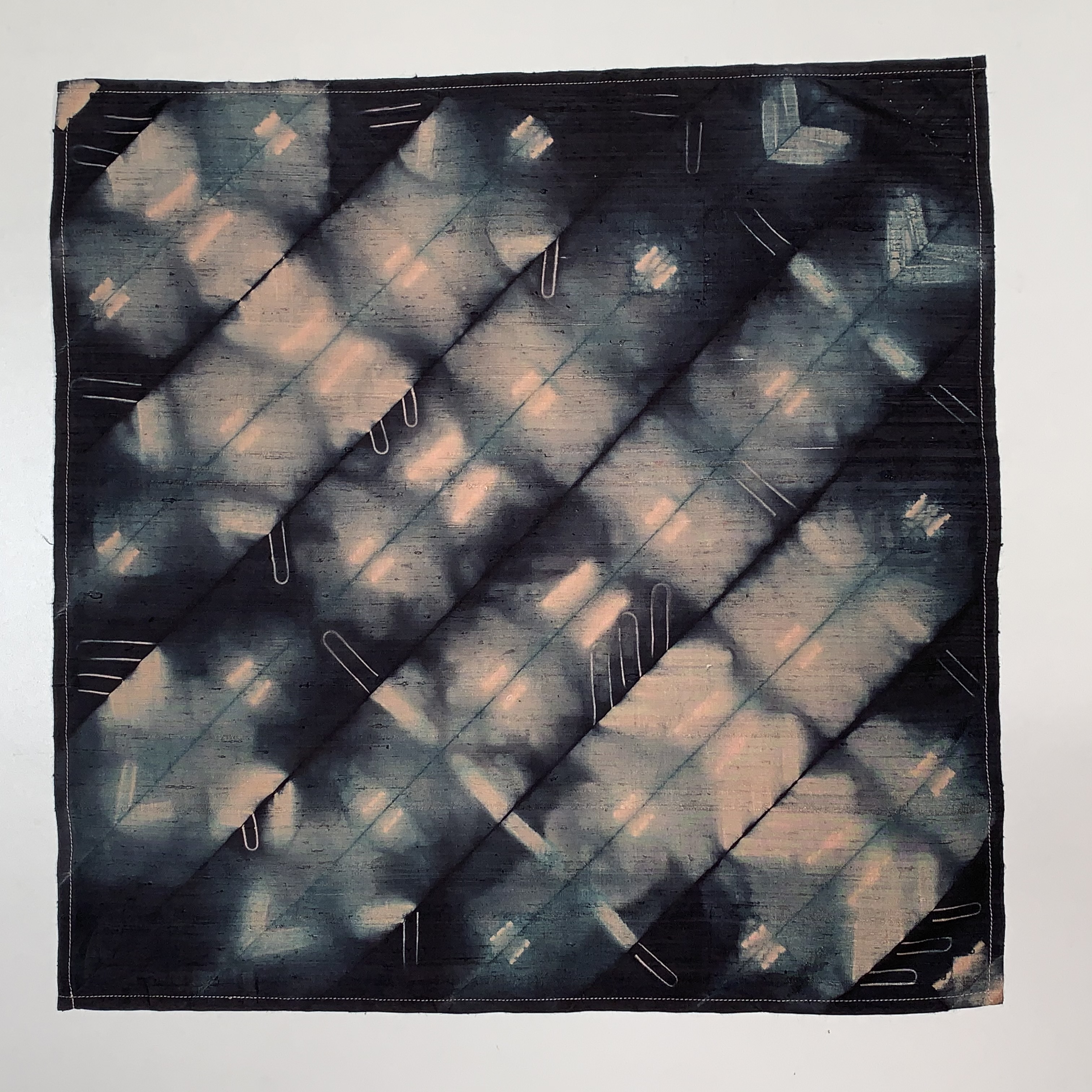
Dinner Napkin (silk dupioni folded on the bias) 16" w x 16" h
NOTES ON MENU DURING CONVERSATIONS WITH JASON and DOMINIQUE
